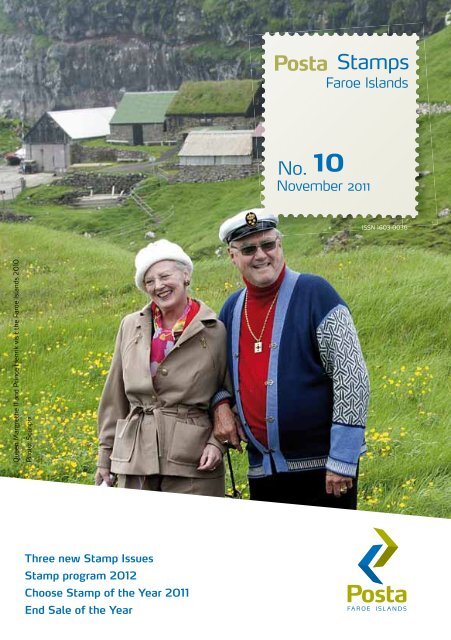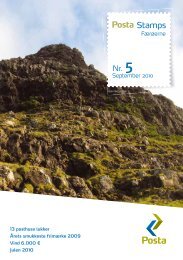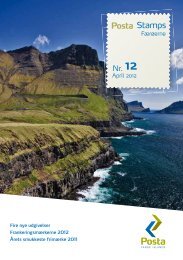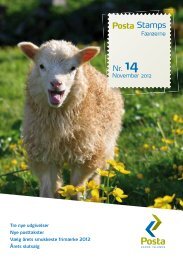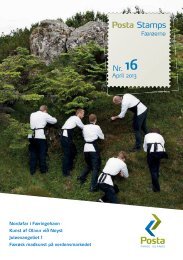Create successful ePaper yourself
Turn your PDF publications into a flip-book with our unique Google optimized e-Paper software.
Queen Margrethe II and Prince Henrik visit the Faroe Islands 20<strong>10</strong><br />
Photo: Scanpix<br />
Three new Stamp Issues<br />
Stamp program 2012<br />
Choose Stamp of the Year 2011<br />
End Sale of the Year<br />
Faroe Islands<br />
No. <strong>10</strong><br />
November 2011<br />
Stamps<br />
ISSN 1603-0036
FO 724<br />
Queen of Denmark <strong>fo</strong>r 40 years<br />
On 14 January 2012, <strong>fo</strong>rty years have passed since<br />
Her Majesty Queen Margrethe II became Queen of<br />
Denmark. Queen Margrethe is the constitutional<br />
head of the Kingdom of Denmark, which includes<br />
Denmark and the two autonomous regions: Greenland<br />
and the Faroe Islands. On this occasion the<br />
Faroese Posta, Post Denmark and Post Greenland<br />
issue a common stamp and a mini-sheet.<br />
Test proof<br />
School in 1959. In 1960 Crown Princess Margrethe<br />
took the obligatory examination in philosophy at<br />
the University of Copenhagen. In 1960-61 she<br />
attended studies in archeology at the University<br />
of Cambridge in England. In the period 1961-62<br />
Margrethe studied political science at University<br />
of Århus, in 1963 she studied in Sorbonne, France<br />
and in 1965 at the London School of Economics.<br />
representatives from each elected party visit her<br />
at Amalienborg Palace and recommend a leader<br />
<strong>fo</strong>r new government negotiations. This person<br />
will then be summoned and appointed <strong>fo</strong>rmal<br />
negotiator. When the political parties in question<br />
have made an agreement <strong>fo</strong>r the terms of a new<br />
government, the new Prime Minister and his/her<br />
Army. It is also the Queen who <strong>fo</strong>rmally welcomes<br />
<strong>fo</strong>reign ambassadors, when they arrive<br />
in Denmark. Additionally, the Queen per<strong>fo</strong>rms<br />
some representative tasks in connection with<br />
anniversaries, inaugurations, premieres, award of<br />
orders, etc.<br />
team of ministers visit the Queen again <strong>fo</strong>r the The Summer Cruise<br />
Queen Margrethe was born on 16 April 1940 at In 1967 Crown Princess Margrethe married the<br />
official approval.<br />
Each year the Queen per<strong>fo</strong>rms a so-called Sum-<br />
Amalienborg Palace in Copenhagen. Her parents French diplomat Henri Marie Jean André Count<br />
mer Cruise to Danish cities – mostly with the<br />
were Crown Prince Frederik, later King Frederik de Laborde de Monpezat, who by this marriage<br />
The State Council<br />
royal yacht “Dannebrog”. At regular intervals, the<br />
IX, and Crown Princess Ingrid. In 1944 and 1946 became Prince Henrik of Denmark. They had<br />
Once a week the Danish State Council is held, summer cruise also includes visits to the Faroe<br />
the couple had two more daughters, respectively two sons, Crown Prince Frederik, born on 26 May<br />
where the Queen meets the Prime Minister and Islands and Greenland. Great numbers of people<br />
Princess Benedikte and Princess Anne-Marie of 1968, and Prince Joachim, born on 7 June 1969.<br />
Government. At this council the Queen or her meet the Queen at her arrivals, and indicate the<br />
Denmark. Princess Margrethe was babtized in<br />
deputy is in<strong>fo</strong>rmed of the Government’s work. It Queen’s popularity in the three countries.<br />
Holmen Church in Copenhagen on 14 May 1940. From Crown Princess to Queen<br />
is also at this meeting that the Queen signs new<br />
Her full name was Margrethe Alexandrine Þórhil- On 14 January 1972 King Frederik IX died. The<br />
laws together with the responsible ministers. The Queen and the Faroe Islands<br />
dur Ingrid. At that time, female succession to the next day, the Crown Princess was hailed as Queen<br />
Since 1380, the Faroe Islands have been part<br />
throne was not an option, so not until the introdu- Margrethe II by Prime Minister Jens Otto Krag at<br />
The Queen’s New Year Speech<br />
of the Kingdom of Denmark -first as a part of<br />
ction of the Act of Succession of 27 March 1953, Christiansborg Castle Square.<br />
Every year on 31 December, Queen Margrethe Norway, then with direct connection to Den-<br />
Princess Margrethe became Crown Princess of<br />
delivers the so-called New Year Speech, which is mark. Although the progress has developed into<br />
Denmark and heir to the throne. On 16 April 1958, The Constitutional Head of State<br />
broadcasted live in Denmark, the Faroe Islands greater political autonomy, Queen Margrethe is<br />
Crown Princess Margrethe took seat in the State Her Majesty Queen Margrethe II is the constitutio-<br />
and Greenland. With this speech the Queen very popular among the Faroese population,<br />
Council and served as head of State Council meetnal Head of State of Denmark, Greenland and the<br />
makes status over the year that has passed. This who have <strong>fo</strong>llowed her since her first visit on<br />
ings when her father King Frederik IX was absent. Faroe Islands. This means that she as a ruler has<br />
tradition is very popular, and although it is not a the islands as a child. The Queen’s insight<br />
no political powers or influence – these lies with<br />
political speech, it may contain a remark or two into Faroese relations and history is highly<br />
Education<br />
the democratically elected parliaments.<br />
of humanitarian or moral character.<br />
appreciated and there is no doubt that a large<br />
The young Princess Margrethe received her<br />
proportion of the population looks <strong>fo</strong>rward to<br />
primary school education at Zahle’s School in The Queen’s role in elections<br />
Other Duties<br />
her traditional summer visits.<br />
Copenhagen from 1946 to 1955. The first couple When time calls <strong>fo</strong>r elections to the Danish Par-<br />
As Head of State, it is the Queen’s duty to<br />
of years though, the education took place at Amaliament, the Prime Minister visits the Queen,<br />
preside at <strong>fo</strong>rmal State Visits, both when she Queen Margrethe II is the Queen of the<br />
lienborg Palace. After a short stay at boarding submits his resignation and recommends general<br />
makes official visits to other countries and when Faroese as well as the Greenlanders and<br />
school in England (1955-56), she started on her elections. When the elections are over, the Queen<br />
<strong>fo</strong>reign Head of States visit Denmark. The Queen Danes, no doubt about that.<br />
high school education and graduated from Zahle’s calls <strong>fo</strong>r a so-called Queen’s Round, where two<br />
of Denmark is <strong>fo</strong>rmally the head of the Danish<br />
2<br />
Anker Eli Petersen<br />
3
FØROYAR<br />
3 KR<br />
FO 725-728<br />
2012<br />
650 FØROYAR<br />
KR<br />
2012<br />
850 FØROYAR<br />
KR<br />
Sea Anemone - Flowers of the Sea<br />
Sea anemone are related to jellyfish and<br />
corals, all of which have a relatively simple<br />
circular body shape with numerous tentacles<br />
surrounding a mouth at one end of the<br />
organism. At the opposite end, sea anemones<br />
have a suction disc with which they can<br />
attach themselves firmly to a hard surface,<br />
whereas jellyfish live their lives swimming<br />
in open waters. In contrast to corals, sea<br />
anemones have no skeleton and act as<br />
independent individuals, whereas corals<br />
<strong>fo</strong>rm colonies.<br />
Sea anemones’ shapes and colours give<br />
them a striking appearance reminiscent of<br />
exotic tropical plants, which also inspired<br />
their name and overall scientific classification,<br />
Anthozoa (Greek: antho=flowers and<br />
zoa=animals).<br />
Sea anemones are <strong>fo</strong>und in all oceans and<br />
at all depths, from just below the water<br />
surface to depths of more than <strong>10</strong>,000<br />
metres. Many species are <strong>fo</strong>und on wharfs<br />
and rocks at the water surface, where they<br />
add colour to the more neutral blue-green<br />
or brown surroundings – one of the reasons<br />
that most people with a relationship to the<br />
sea are <strong>fo</strong>nd of them. In unsteady waters or<br />
2012<br />
<strong>10</strong> 50<br />
FØROYAR<br />
KR<br />
when touched, the sea anemone retracts its<br />
tentacles into its tubular body, appearing as<br />
a hemisphere with a hole at the top.<br />
Despite their flower-like appearance, most<br />
sea anemones are predators. They have<br />
numerous poisonous cells on their surface –<br />
especially on their tentacles, each of which<br />
can hold about 2 million of these cells. The<br />
poisonous cells paralyse prey, after which<br />
it is captured and transported through the<br />
sea anemone’s mouth and into its intestinal<br />
cavity, where it is digested.<br />
The sea anemone can only attach itself to a<br />
hard surface. It is able to slowly glide on its<br />
<strong>fo</strong>ot at a speed of less than <strong>10</strong> cm per hour.<br />
There are certain species that can release<br />
their grip on the surface and float with the<br />
current if necessary, and others can even<br />
swim using their tentacles, which can help<br />
to escape from an approaching predator.<br />
The sea anemone’s enemies include nudibranchs,<br />
fish and starfish. However, sea<br />
anemones have a very high capacity <strong>fo</strong>r<br />
regeneration. Parts of the animal torn off<br />
due to bad weather or a predator grow back<br />
again.<br />
2012<br />
4 5<br />
FO 718<br />
Photo: Ingi Sørensen<br />
It is not uncommon <strong>fo</strong>r sea anemones to<br />
be attached to other animals, such as the<br />
hermit crab. In this way, sea anemones<br />
come in contact with more potential <strong>fo</strong>od<br />
– and the behaviour of the hermit crab can<br />
attract potential prey of the sea anemone.<br />
In return, the hermit crab is protected by<br />
the sea anemone from infection by larvae<br />
of various crustacean parasites.<br />
Sea anemones reproduce both sexually,<br />
with sperm and eggs, and asexually, typically<br />
through pedal laceration, in which a<br />
small piece of the pedal disc breaks off.<br />
This piece then develops into a new sea<br />
anemone that is a clone of the mother.<br />
Marine biologists consider difficult to<br />
determine the species of sea anemones.<br />
Conservation of this animal group requires<br />
special methods and specialist knowledge<br />
is required to ensure correct identification.<br />
Although the sea anemone fauna in the<br />
Faroese area is not yet completely documented,<br />
it can be characterised as Nordic<br />
– or in scientific terms, East Atlantic Boreal<br />
– with an Arctic touch. Thirty species of<br />
sea anemone have been identified in the<br />
Faroes, but the total number of species is<br />
presumably higher.<br />
The size of Faroese sea anemones varies<br />
greatly. The diameter of fully grown sea<br />
anemones varies from more than 30 centimetres<br />
<strong>fo</strong>r the largest species, Bolocera<br />
tuediae, down to a couple of millimetres<br />
with Edvardisia danica. The longest species<br />
in the Nordic seas is the very common Frilled<br />
Anemone (Metridium senile), which can<br />
reach lengths of a half metre. Some species<br />
of sea anemone can reach a considerable<br />
age; <strong>fo</strong>r example, a sea anemone of the<br />
species Actinia equina has lived <strong>fo</strong>r more<br />
than 66 years in an aquarium.<br />
Ámundur Nolsø
TÓRSHAVN · ÚTGÁVUDAGIN<br />
20 · 2 · 2012<br />
FO 729-730<br />
Animals of the Viking Age<br />
The Great Auk<br />
Latin: Pinguinus impennis<br />
The Great Auk was a bird of the genus Alca,<br />
which also includes the Little Auk, Common<br />
Murre, Razor Bill and Atlantic Puffin.<br />
All of these species live or lived in the North<br />
Atlantic. The Great Auk was the largest of<br />
these birds and could grow up to 70 cm in<br />
height. Some of the other Alca birds had<br />
bright or whitish abdomens and dark-black<br />
backs, with a characteristic white spot on<br />
each side of the head, between the eyes<br />
and eye socket. They were flightless birds,<br />
with wings that were as small as the South<br />
Atlantic penguin. It was fast in the water<br />
when hunting fish but very clumsy on land.<br />
The Great Auk lived in large colonies along<br />
the coast on both sides of the North Atlantic,<br />
so far south that remains of the bird are<br />
<strong>fo</strong>und in Stone Age and Viking Age kitchen<br />
middens.<br />
The bird’s fate was sealed because it was<br />
easy to hunt and butcher. Already in the 15th<br />
century, the Great Auk was more or less<br />
extinct in Northern Europe but large colonies<br />
remained in Greenland, Iceland, New<strong>fo</strong>undland,<br />
Baffin Island and Labrador. When cod<br />
Test proof<br />
fishing began in New<strong>fo</strong>undland and whale<br />
hunting began in the North Atlantic, the<br />
Great Auk’s fate was sealed. The fishing<br />
and hunting boats only had supplies <strong>fo</strong>r the<br />
trip out, so the Great Auk was taken alive or<br />
butchered onboard the boats <strong>fo</strong>r the return<br />
journey.<br />
The most famous colony was on the Penguin<br />
Islands (called Funk Island today),<br />
which lies north east of New<strong>fo</strong>undland. The<br />
last Great Auks were killed in 1801-1802. At<br />
that point people were aware of how rare<br />
the bird had become and European museums<br />
were willing to pay a <strong>fo</strong>rtune to get<br />
hold of the skin of the Great Auk be<strong>fo</strong>re it<br />
became extinct. The last Great Auks were<br />
taken in 1844 on the small island Eldey<br />
south of Reykjanes, Iceland, but there were<br />
unconfirmed observations of the Great Auk<br />
in Vardø in Norway in 1848 and several<br />
times in Greenland in the 1850s. But the<br />
bird is now extinct.<br />
The Great Auk was a summer visitor to the<br />
Faroe Islands but there was never any evidence<br />
that it bred there. The last bird was<br />
taken at Stóra Dímun on 1 July 1808.<br />
There exist a few stuffed examples of the<br />
Great Auk, <strong>fo</strong>r example Iceland purchased<br />
a pair that can be seen today in the Natural<br />
History Museum of Iceland. The Zoological<br />
Museum in Copenhagen has used the Great<br />
Auk as a logo <strong>fo</strong>r many years. Ole Worm's<br />
Museum Wormianum in Copenhagen was<br />
sent a living Great Auk. It was drawn showing<br />
a ring around its neck, which meant that<br />
it had been tethered.<br />
The Great Auk is an example of a bird that<br />
was hunted to extinction purely because of<br />
a lack of knowledge about its population<br />
distribution. The fishermen of the day cannot<br />
be reproached <strong>fo</strong>r this, since they did not<br />
have the benefit of modern communication<br />
technology. But the museums could have<br />
perhaps tried to save the Great Auk rather<br />
than have helped to deliver the final blow.<br />
Dímun Sheep<br />
Latin: Ovis aries<br />
In the summer of 1844, the then Danish<br />
Crown Prince, who would later go on to<br />
become King Frederik VII, visited the Faroe<br />
Islands. Among the royal entourage was<br />
a young zoologist by the name of Japetus<br />
Steenstrup, who had been sent by the Royal<br />
Natural History Museum of Denmark to<br />
collect specimens <strong>fo</strong>r the museum. In the<br />
Zoological Museum’s collection records of<br />
23 August 1844, it states:<br />
“HRH the Crown Prince with Professor<br />
Steenstrup gave the <strong>fo</strong>llowing items to the<br />
museum:<br />
1. 18-<strong>fo</strong>ot skeleton of Delphinus globiceps<br />
(pilot whale).<br />
2. The feral variety of the Faroese<br />
sheep. No hair at the base of the horns or<br />
around the ears. The skull was loose.<br />
3. Second specimen. Well preserved.<br />
The skull was loose.<br />
4. The same juvenile. Male lamb.<br />
Well preserved. The skull was loose.<br />
In 1983, the three specimens were returned<br />
to the Faroe Islands as part of the opening<br />
of Nordic House in the Faroe Islands and<br />
today they can be seen in the National<br />
Museum of the Faroe Islands.<br />
The sheep are small and black and look<br />
a little like the more primitive feral Soay<br />
sheep that live on the island of St Kilda in<br />
the Outer Hebrides. They are called the<br />
goat-horned sheep, because both sexes<br />
have horns, though the ewe’s horns are<br />
6 7
smaller and more delicate than the ram’s<br />
horns. The Dímun sheep are more developed<br />
compared to the Soay sheep, which<br />
have the wild sheep’s light belly. Woollen<br />
garments recovered from Bronze Age burial<br />
sites have the same kind of wool and structure<br />
that is <strong>fo</strong>und on the Dímun sheep, so<br />
even at this early stage, wool from these<br />
sheep was being used.<br />
The three sheep from Stóra Dímun were<br />
among the last of the original sheep in the<br />
Faroe Islands, and were perhaps brought by<br />
the Vikings. In an excavation in Eiði in the<br />
north end of Eysturoy, half a skull of the<br />
same kind of sheep was <strong>fo</strong>und. The Vikings<br />
brought their own sheep to Iceland and<br />
Greenland and almost certainly when they<br />
came to the Faroe Islands.<br />
Around 1600, almost all of the sheep on the<br />
Faroe Islands were wiped out by disease.<br />
New sheep were introduced from Shetland<br />
and Iceland. But the small black sheep on<br />
Lítlu Dímun managed to survive, although<br />
by 1860 they were finally wiped out by hunting.<br />
FO 722-723<br />
A description of the final shooting of the last<br />
sheep on Lítlu Dímun exists. On 5 February<br />
1911, the Justice of the Peace R. Müller<br />
wrote in the Danish newspaper Nationaltidende:<br />
“The remaining sheep were so wild that they<br />
would rather jump in into the abyss than be<br />
caught, especially some of the old rams and<br />
ewes, who were impossible to get near. So<br />
you had to take your rifle and shoot the last<br />
of them. The late J. Mortensen, merchant<br />
and <strong>fo</strong>under of the largest trading establishment<br />
in the Faroe Islands, was a gifted<br />
shooter and he told me that he shot several<br />
of these sheep and that he had shot the last<br />
of them, an old ram that was so careful that<br />
shooting it cost him a great deal of ef<strong>fo</strong>rt.”<br />
Dorethe Block<br />
Queen <strong>fo</strong>r 40 years<br />
Black Print in a limited edition &<br />
souvenir <strong>fo</strong>lder<br />
In connection with the stamp issue “Queen<br />
<strong>fo</strong>r 40 years” which is a joint issue between<br />
the Faroe Island, Denmark and Greenland<br />
some special products have been produced.<br />
A beautiful souvenir <strong>fo</strong>lder with all three<br />
souvenir sheets has been made and also a<br />
so called black print of the stamp. All the<br />
black press are numbered and signed by<br />
hand by the artist Mikael Melby and the<br />
graveur Martin Mörck. They will be delivered<br />
in a card.<br />
This is the first time that Posta Faroe<br />
Islands sells a black print as a special product.<br />
It is only made in a limited edition, so<br />
you have to order it right away to be sure to<br />
get one copy.<br />
The souvenir <strong>fo</strong>lder with the three souvenir<br />
sheets costs 45,- DKK<br />
The black press costs <strong>10</strong>0,- DKK<br />
We will also be selling the products from<br />
Denmark and Greenland belonging to this<br />
issue. That means that we will be selling the<br />
<strong>stamps</strong> and the minisheets as well as the<br />
first days covers of “Queen <strong>fo</strong>r 40 years”.<br />
But we will not be selling the cancelled<br />
<strong>stamps</strong> from these countries.<br />
All these products can be ordered through<br />
the order <strong>fo</strong>rm which is placed in the middle<br />
of this magazine and on our web-page<br />
www.<strong>stamps</strong>.<strong>fo</strong><br />
8 9
4. January<br />
Stamp Program 2012<br />
Margrethe II – Queen <strong>fo</strong>r 40 years<br />
Posta Faroe Islands, Post Denmark and<br />
Post Greenland issue a common stamp<br />
issue on this occasion. Value: <strong>10</strong>,50<br />
kr. FO 724. It will be issued both<br />
as a minisheet and as a single stamp.<br />
NB! This issue will be sent to the subscribers<br />
together with the February-issue.<br />
20. February<br />
Sea anemone<br />
- <strong>fo</strong>ur single <strong>stamps</strong> with photos of sea<br />
anemones. Photographer: Ingi Sørensen. A<br />
booklet with 8 selfadhesive <strong>stamps</strong> will also<br />
be published. Value: 3,00, 6,50, 8,50 and<br />
<strong>10</strong>,50 kr. FO 725-728.<br />
The animals of the vikings<br />
- two <strong>stamps</strong>. Astrid Andreassen has drawn<br />
the great auk and the Dimon-sheep. Value:<br />
13,00 and 21,00 kr. FO 729-730.<br />
21. March<br />
Nordic issue 2012 - Life at sea<br />
- minisheet with two <strong>stamps</strong> showing sea rescue.<br />
Artist: Edward Fuglø.<br />
Value: 2 x <strong>10</strong>,50 kr. FO 731-732.<br />
NB! This issue will be sent to the subscribers<br />
together with the April-issue.<br />
30. april<br />
FØROYAR<br />
3 KR<br />
Europa 2012: visit<br />
– two single <strong>stamps</strong>. Photos showing activities in the<br />
Faroe Islands. To postcards will also be published.<br />
Value: 6,50 and <strong>10</strong>,50 kr. FO 733-734.<br />
Monsters<br />
- <strong>fo</strong>ur single <strong>stamps</strong> with drawings of Edward<br />
Fuglø. Values: 6,50, 11,00, 17,00 and 19,00 kr.<br />
FO 735-738.<br />
2012<br />
650 FØROYAR<br />
KR<br />
FO 731-732<br />
Á havinum - bjargingartænasta<br />
EDWARD FUGLØ 2012<br />
2012<br />
850 FØROYAR<br />
KR<br />
FØROYAR FØROYAR<strong>10</strong>KR<br />
50<br />
<strong>10</strong>KR<br />
50<br />
Edward Fuglø 2012<br />
Edward Fuglø 2012<br />
17 KR<br />
EDWARD FUGLØ 2012<br />
6,50 KR Marra<br />
Gryla<br />
2012<br />
F Ø R O Y A R F Ø R O Y A R<br />
F Ø R O Y A R<br />
F Ø R O Y A R<br />
<strong>10</strong> 50<br />
FØROYAR<br />
KR<br />
11 KR<br />
Edward Fuglø 2012<br />
19 KR<br />
Edward Fuglø 2012<br />
2012<br />
24. september<br />
Regin the Blacksmith- Faroese ballad<br />
- sheetlet with six <strong>stamps</strong>. Artist: Anker Eli<br />
Petersen. Value: 6 x 11,00 kr. FO 739-744.<br />
Nordic modern art:<br />
Jan Håfstrøm & Edward Fuglø<br />
- two single <strong>stamps</strong> with paintings of these<br />
two artists. Value: 13,00 and 21,00 kr.<br />
FO 745-746.<br />
The old pharmacy in Klaksvík 80 years:<br />
- one stamp. Photo of the old pharmacy in<br />
Klaksvík. Artist: Anker Eli Petersen. Value:<br />
8,50 kr. FO 747.<br />
Christmas Carols 3<br />
- two single <strong>stamps</strong> illustrating the third<br />
issue of the series Christmas Carols.<br />
"Gleðilig jól" and "Jól hava einglaljóð".<br />
Artist: Anker Eli Petersen. A booklet with<br />
8 <strong>stamps</strong> and two postcards will also<br />
be published. Value: 6,50 and <strong>10</strong>,50 kr.<br />
FO 748-749.DKK.<br />
Franking labels 2012<br />
Four franking labels.<br />
The motif is StreetArt. Artists: young people<br />
from the Youth House "Margarinfabrikkin".<br />
5. november<br />
Yearbook, year pack (300,50 kr.) and the Christmas<br />
Seals. Janus Guttesen will be drawing the Christmas<br />
Seals 2012.<br />
NB! This programme may change<br />
FØROYAR 13 KR<br />
FØROYAR 21 KR<br />
<strong>10</strong> 11
FØROYAR 6 KR<br />
Vote <strong>fo</strong>r Stamp of the Year 2011<br />
- 1. prize is a trip to the Faroe Islands!<br />
Ketta Felis silvestris catus Edward Fuglø 2011<br />
anker eli 2011<br />
FO 700 FO 701 FO 702<br />
Ketta Felis silvestris catus Edward Fuglø 2011 FØROYAR<br />
<strong>10</strong> KR<br />
FO 703 FO 704<br />
FO 708 FO 709<br />
FO 712 FO 713<br />
FO 714 FO 715<br />
FØROYAR<br />
0,50 KR<br />
Edward Fuglø . 2011<br />
Einiber Juniperus communis subsp. alpina<br />
FO 7<strong>10</strong><br />
FØROYAR<br />
6,50 KR<br />
Edward Fuglø . 2011<br />
Krákuber Empetrum nigrum subs. hermaphroditum<br />
FO 716 FO 717<br />
FO 718<br />
FO 711<br />
FO 705-707<br />
ELLISAKFØR<br />
12 13<br />
FØROYAR<br />
Edward Fuglø, 2011 13 KR<br />
FØROYAR<br />
Edward Fuglø, 2011 13 KR<br />
2.prize:<br />
Name:<br />
Address:<br />
Postal Code/Town:<br />
Country:<br />
E-mail:<br />
Client No..:<br />
FØROYAR<br />
Edward Fuglø, 2011 13 KR<br />
FØROYAR<br />
Edward Fuglø, 2011 13 KR<br />
FØROYAR<br />
Edward Fuglø, 2011 13 KR<br />
FØROYAR<br />
Edward Fuglø, 2011 13 KR<br />
FO 719 FO 720 FO 721<br />
3.prize:<br />
This year's Grand Prize is a trip to the Faroe Islands.<br />
The trip is <strong>fo</strong>r one person only and the winner can<br />
travel to the Faroe Islands by ship or plane in the<br />
summer 2012. Four night at a hotel by further<br />
agreement with full board are included.<br />
The winner of the 2nd prize can choose one of the<br />
FO 719-721<br />
FO 719-721<br />
Cut out the coupon and send it to us or you can vote on www.<strong>stamps</strong>.<strong>fo</strong><br />
The deadline <strong>fo</strong>r voting is 15 March 2012!<br />
Yes, I would like to register <strong>fo</strong>r the e-newsletter from<br />
Posta Stamps sent by e-mail.<br />
E-Mail:<br />
Stamp of the year<br />
2011 is:<br />
FO 722<br />
FO 723<br />
beautiful glass figurines pictured on the left. They<br />
are handmade by Mikkalina glass, and are 30 cm<br />
tall. Value: 1.000 DKK. You can read more about<br />
them at www.mikkalina.com.<br />
Last, but not least, 5 lucky winners will be drawn<br />
<strong>fo</strong>r a yearbook 20<strong>10</strong>.
Please note that 31 December 2011 is the<br />
last date of sale <strong>fo</strong>r the <strong>stamps</strong> and articles<br />
presented on these pages.<br />
It is there<strong>fo</strong>re your last oppurtunity to purchase<br />
the <strong>stamps</strong> at the nominal value.<br />
Tuberklastøðin <strong>10</strong>0 ár<br />
Clearance Sale<br />
of the Year<br />
Tuberklastøðin <strong>10</strong>0 ár<br />
FØROYAR 5,50 FØROYAR 9,00<br />
FO 649-650<br />
The articles can be ordered by completing<br />
the enclosed coupon or by visiting our webshop<br />
at www.<strong>stamps</strong>.<strong>fo</strong>.<br />
FO 624-625 FO 627<br />
FO 626<br />
FO 630-631<br />
FO 618-623 FO 628-629<br />
FDC-<strong>fo</strong>lder 2007<br />
Booklet<strong>fo</strong>lder 2007<br />
14 15<br />
FO 639-648<br />
Yearbook 2007<br />
Yearpack 2007<br />
FO 632-637
New Stamp Issues 4 January and 20 February 2012<br />
FØROYAR<br />
3 KR<br />
2012<br />
650 FØROYAR<br />
KR<br />
Posta Stamps<br />
Óðinshædd 2<br />
FO-<strong>10</strong>0 Tórshavn<br />
Faroe Islands<br />
Tel. +298 346200<br />
Fax +298 346201<br />
<strong>stamps</strong>@posta.<strong>fo</strong><br />
www.<strong>stamps</strong>.<strong>fo</strong><br />
2012<br />
850 FØROYAR<br />
KR<br />
2012<br />
Test proof<br />
<strong>10</strong> 50<br />
FØROYAR<br />
KR<br />
2012 Test proof<br />
Test proof<br />
New stamp issue:<br />
Date of issue:<br />
Value:<br />
Numbers:<br />
Stamp size:<br />
Sheet size:<br />
Artist:<br />
Printing method:<br />
Engraver:<br />
Printer:<br />
Postal use:<br />
New stamp issue:<br />
Date of issue:<br />
Value:<br />
Numbers:<br />
Stamp size:<br />
Drawings:<br />
Printing method:<br />
Printer:<br />
Postal use:<br />
New stamp issue:<br />
Date of issue:<br />
Value:<br />
Numbers:<br />
Stamp size:<br />
Layout:<br />
Printing method:<br />
Printer:<br />
Postal use:<br />
Queen of Denmark <strong>fo</strong>r 40 years<br />
04.01.2012<br />
<strong>10</strong>,50 DKK<br />
FO 724<br />
38,4 x 28,8 mm<br />
<strong>10</strong>5 x 70 mm<br />
Mikael Melbye<br />
Intaglio/Offset<br />
Martin Mörck<br />
Post Danmark Frimærker<br />
Small letters to Europe, 0-50 g<br />
Sea Anemones<br />
20.02.2012<br />
3,00, 6,50, 8,50 og <strong>10</strong>,50 DKK<br />
FO 725-728<br />
28,0 x 40,0 mm<br />
Ingi Sørensen<br />
Offset<br />
OeCd, Austria<br />
Complimentary value, inland small letters and<br />
small letters to Europe, 0-50 g<br />
Animals of the viking age<br />
20.02.2012<br />
13,00 and 21,00 DKK<br />
FO 729-730<br />
40 x 22,5 & 22,5 x 40 mm<br />
Astrid Andreasen<br />
Offset<br />
Cartor Security, Frakland<br />
Small letters outside Europe 0-50 g and large<br />
letters inland <strong>10</strong>1-250 g<br />
Layout: Posta Stamps - Printer: TrykTeam, Denmark


